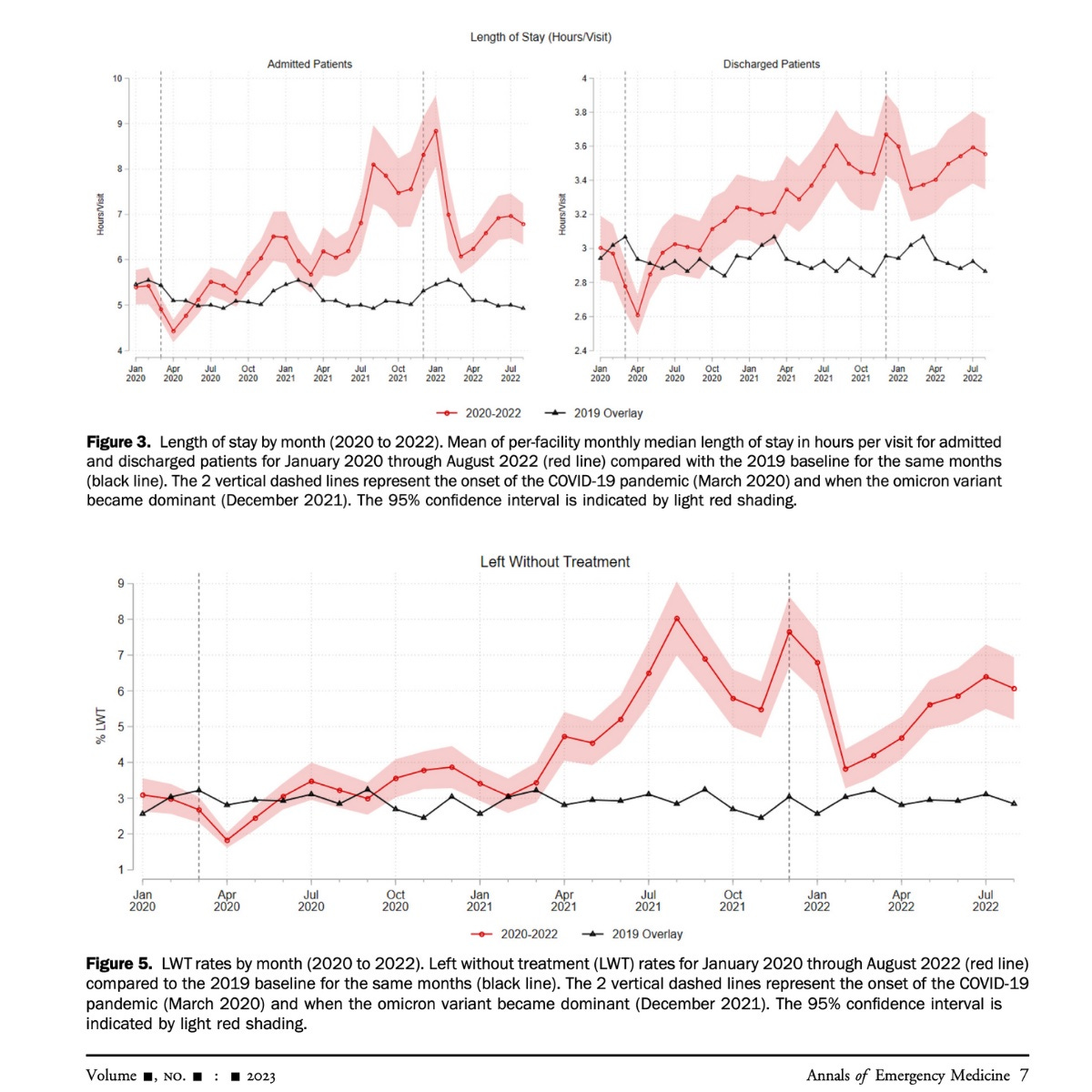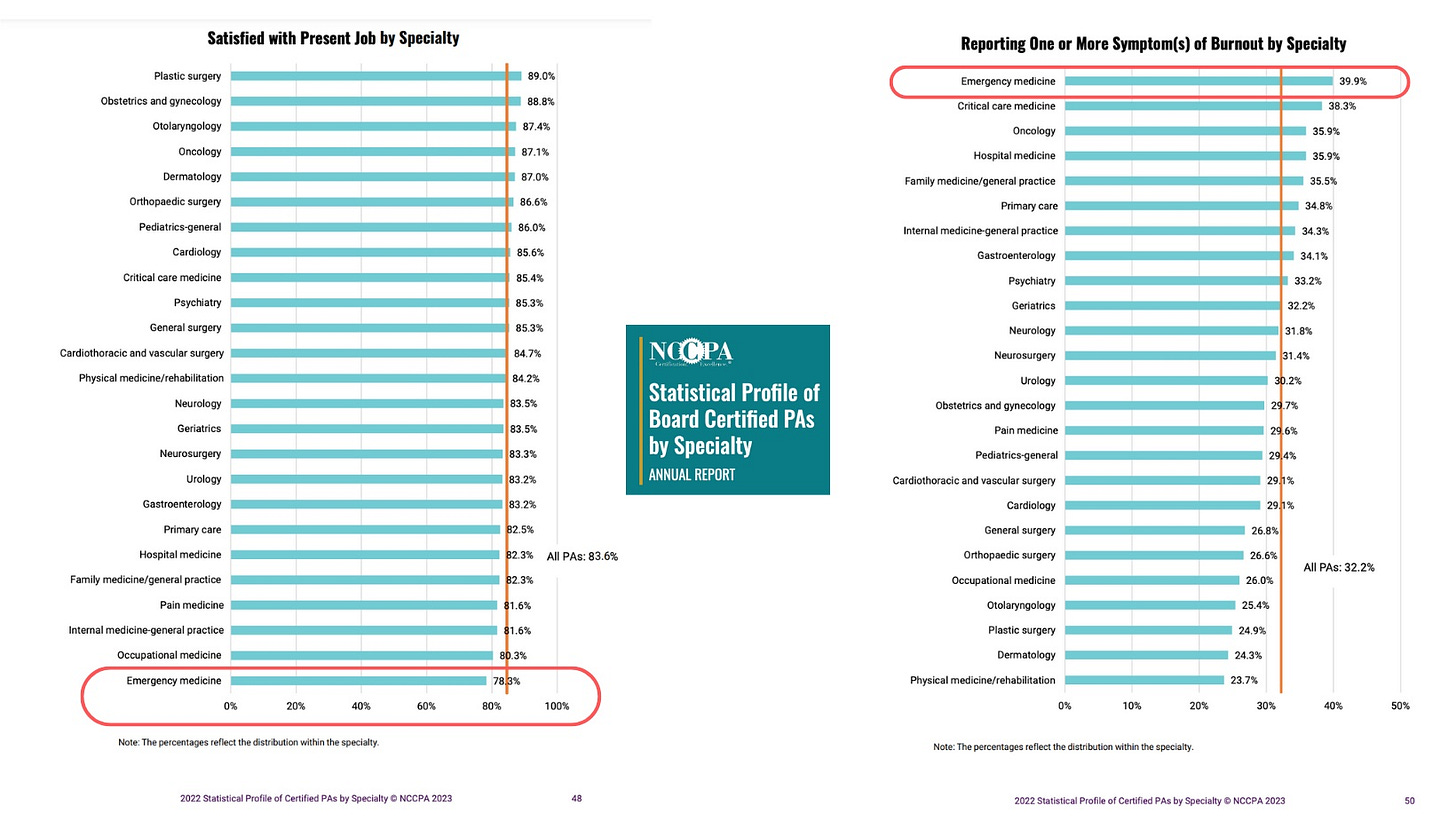EM’s only public company is struggling
Also: USACS on social, hospital bottleneck data, survey of PA job satisfaction, TMA wins, daily workplace violence, and the healing power of pets.
Top of the Week
Nutex Health, which operates micro-hospitals and freestanding emergency departments, is emergency medicine’s only public company. Nutex went public on April 4, 2022, through a special purpose acquisition company (SPAC). NUTX’s stock price closed at $26.64 on 4/5/2022; currently, the price is at $0.28. That’s a 99% decrease.
Being a public company, Nutex Health releases quarterly financial reports, giving us visibility into the company’s business challenges. Let’s dive into Nutex’s latest SEC report for learnings relevant to the emergency medicine market.
Nutex’s company description: “NutexHealth Inc. is a physician-led healthcare services and operations company with 20 hospital facilities in eight states (hospital division), and a primary care-centric, risk-bearing population health management division. Our hospital division implements and operates different innovative healthcare models, including micro-hospitals, specialty hospitals, and hospital outpatient departments ("HOPDs”). The population health management division owns and operates provider networks such as independent physician associations ("IPAs”) and offers a cloud-based proprietary technology platform to IPAs which aggregates clinical and claims data across multiple settings, information systems, and sources to create a holistic view of patients and providers. We employ approximately 800 full-time employees and partner with over 900 physicians.”
Nutex does not employ its affiliated emergency physicians. “The Physician LLCs employ the doctors who work in our hospitals. We have no direct ownership interest in these entities but they are owned and, in some instances, controlled by related parties including our CEO, Dr. Thomas Vo.”
Nutex’s H1 2023 finances are in rough shape. The company’s year-to-date 2023 gross profit margin is 12.6%, compared to the market’s average gross profit of 36.2%. After incorporating Nutex’s general and administrative expenses (executive management, accounting, human resources, corporate technology, insurance, and professional fees), Nutex’s 2023 operating income was -4.2% of revenue. When other expenses such as interest and taxes are included, Nutex’s net income for H1 2023 was -7.5% of revenue.
Nutex’s struggles are largely due to the No Surprises Act. Nutex reports: “Since the NSA became effective January 1, 2022, our average payment by insurers of patient claims for emergency services has declined by approximately 30%.” Thirty percent! Before the NSA made balance billing illegal, Nutex relied heavily on out-of-network billing.
In contrast to most EDs, Nutex cannot increase revenues by seeing more low-margin Medicare and Medicaid patients. Nutex appears not to accept government insurance at most of its facilities; only 1% of Nutex reimbursement comes from Medicare or Medicaid patients.
Insurance companies’ power to drive down reimbursement rates - with assistance from No Surprises Act regulations - threatens Nutex’s business model. “Our experience, like that of many other healthcare providers, is that the [No Surprises Act] final rule continues to unfairly favor insurers in the determination of the QPA we receive for our healthcare services. It is difficult to predict the outcome of efforts to challenge or amend the final rule. As well, there can be no assurance that third-party payors will not attempt to further reduce the rates they pay for our services or that additional rules issued under the NSA will not have adverse consequences to our business.”
EM Practice
What happens to emergency department patient flow when nurses disappear, mental health patients board, skilled nursing facilities close, and an increasing number of sick patients need treatment? Jonathan Oskvarek et al show the answer with graphic detail in their new Annals of Emergency Medicine article, "Emergency Department Volume, Severity, and Crowding Since the Onset of the Coronavirus Disease 2019 Pandemic". “Total patient hours, a marker for ED workload, was 20% above pre-pandemic levels in late 2022 for ED admissions despite fewer admitted patients. Higher total patient hours were driven by an approximately 40% increase in length of stay for admissions.”
The 2023 E/M documentation rule changes were supposed to unburden emergency physicians from onerous charting requirements. Despite intensive change management, the Geisinger Health System has not seen a decrease in emergency medicine documentation time. Let’s hope AI-powered ambient documentation companies (see Augmedix, Abridge, & Nuance) are more successful at unburdening physicians from wasteful & frustrating documentation processes.
The National Commission on Certification of Physician Assistants (NCCPA) survey of 140,815 US PAs showed that EM is the specialty with the lowest job satisfaction and highest burnout rate.
USACS’ leadership is initiating important conversations on social media about consolidation, physician ownership, and management structures in emergency medicine. Check out these threads on Facebook EM Docs group (PW protected): here & here.
Indiana University studied the incidence of workplace violence at their large urban ED. “Over the 5-month survey period, 130 reports of workplace violence were recorded, on average 0.85 per day.” Amy Faith Ho explores why violence is so common in healthcare.
My conversation with Amy Faith Ho on ACEP Nowcast about how the business of EM is like Game of Thrones, as well as the wonders & challenges of entrepreneurship.
House of Medicine
The Texas Medical Association has won all four of its lawsuits against the US Department of Health & Human Services regarding No Surprises Act regulations. Check out EDPMA’s and Ed Gaines’ updates on the state of the NSA.
Washington Post answers why physicians tend to make more money in rural areas. “You may have to pay doctors more to lure them away from the big cities. Say what you will about big skies, rolling hills and fresh air; many educated young professionals making $405,000 a year can find more fun ways to spend that money in New York’s Manhattan than in Manhattan, Kan.”
From JAMA Surgery & WSJ: outcomes are better for female surgeons than male colleagues.
Hospitals & Health Systems
Gist Healthcare’s forecast of changes in US healthcare’s site of care use:
US hospitals’ financial performance stalled in July.
HCA is moving forward with AI-powered ED documentation. “Earlier this year, HCA Healthcare launched a pilot program that equipped 75 emergency room physicians at four hospitals with Google’s AI technology, utilizing an ongoing partnership with Google Cloud and Augmedix, a tech company specializing in ambient medical documentation. Now, the national provider is weighing up further expansion of the collaboration to incorporate the tech giant’s generative AI tools in more hospitals later this year.”
The Dispo
Inspiring story of the week: “Dog repeatedly escapes Up North shelter, sneaks into nursing home.”
Emergency Medicine Workforce Productions is sponsored by Ivy Clinicians - simplifying the emergency medicine job search through transparency.












